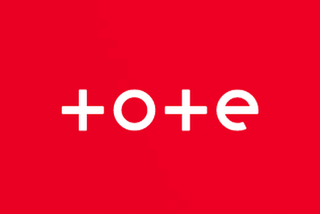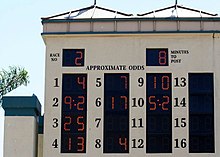
Parimutuel betting or pool betting is a betting system in which all bets of a particular type are placed together in a pool; taxes and the "house-take" or "vigorish" are deducted, and payoff odds are calculated by sharing the pool among all winning bets. In some countries it is known as the tote after the totalisator, which calculates and displays bets already made.

Greyhound racing is an organized, competitive sport in which greyhounds are raced around a track. There are two forms of greyhound racing, track racing and coursing; the latter is now banned in most countries. Track racing uses an artificial lure that travels ahead of the greyhounds on a rail until the greyhounds cross the finish line. As with horse racing, greyhound races often allow the public to bet on the outcome.

Thoroughbred horse racing is a spectator sport in Australia, and gambling on horse races is a very popular pastime with A$14.3 billion wagered in 2009/10 with bookmakers and the Totalisator Agency Board (TAB). The two forms of Thoroughbred horseracing in Australia are flat racing, and races over fences or hurdles in Victoria and South Australia. Thoroughbred racing is the third most attended spectator sport in Australia, behind Australian rules football and rugby league, with almost two million admissions to 360 registered racecourses throughout Australia in 2009/10. Horseracing commenced soon after European settlement, and is now well-appointed with automatic totalizators, starting gates and photo finish cameras on nearly all Australian racecourses.
The superfecta is a type of wager in the United States and Canada parimutuel betting in which the bettor, in order to win, must pick the first four finishers of a race in the correct sequence. This is even more unlikely than a successful wager in the trifecta, which requires correctly picking the first three finishers in order, and as such will have a correspondingly higher payoff.
The Australian and New Zealand punting glossary explains some of the terms, jargon and slang which are commonly used and heard on Australian and New Zealand racecourses, in TABs, on radio, and in the horse racing media. Some terms are peculiar to Australia, such as references to bookmakers, but most are used in both countries.
Harringay Stadium was a major greyhound racing and motorcycle speedway venue in Harringay, north London. It was built and opened in 1927 and closed in 1987.

Sir George Alfred Julius was an English-born New Zealand inventor and entrepreneur. He was the founder of Julius Poole & Gibson Pty Ltd and Automatic Totalisators Ltd, and invented the world's first automatic totalisator.

The Totalisator Agency Board, universally shortened to TAB or T.A.B., is the name given to monopoly totalisator organisations in Australia, New Zealand and South Africa. They operate betting shops and online betting. They were originally government owned, but in Australia most have been privatised. In Victoria, for instance, the Victorian Totalisator Agency Board began operating in March 1961 as a state enterprise, and was privatised in 1994.
Henry Lobe Straus was an American electrical engineer, horse and cattle breeder, sportsman, entrepreneur and computer pioneer.
A daily double is a parimutuel wager offered by horse and dog racing tracks in North America. Bettors wager on the winners of two races, pre-designated by the track for a particular race day. The Daily Racing Form's glossary defines a daily double as two consecutive races.. Because of the increased difficulty of picking two straight winners, winning daily double bets pay off at higher odds than betting both horses to win, or even parlaying them, due to the lack of a second win takeout. The daily double is usually the first two races on the card, but most racetracks have now included a "late daily double"
A betting pool, syndicate, sports lottery, sweep, or office pool if done at work, is a form of gambling, specifically a variant of parimutuel betting influenced by lotteries, where gamblers pay a fixed price into a pool, and then make a selection on an outcome, usually related to sport. In an informal game, the vig is usually quite small or non-existent. The pool is evenly divided between those that have made the correct selection. There are no odds involved; each winner's payoff depends simply on the number of gamblers and the number of winners.

Light & Wonder, Inc., formerly Scientific Games Corporation (SG), is an American corporation that provides gambling products and services. The company is headquartered in Las Vegas, Nevada.

The Hialeah Park Race Track is a historic racetrack in Hialeah, Florida. Its site covers 40 square blocks of central-east side Hialeah from Palm Avenue east to East 4th Avenue, and from East 22nd Street on the south to East 32nd Street on the north. On March 5, 1979, it was added to the U.S. National Register of Historic Places. Another listing for it was added in 1988. The Hialeah Park Race Track is served by the Miami Metrorail at the Hialeah Station at Palm Avenue and East 21st Street.

A starting gate, also called a starting barrier or starting stalls, is a machine used to ensure a fair start to in horse racing and dog racing.
The American Totalisator Company, known today as AmTote International and often referred to as AmTote, specializes in totalisator equipment used to control parimutuel betting at horse racing, greyhound racing, and jai-alai facilities.

Tote Ireland is an Irish gambling company founded in 1929. It is Ireland’s largest pool betting operator. Its product offering also includes sports betting. Business operations are led from its headquarters in Kildare.

Cluden Racecourse is a heritage-listed racecourse at 1 Racecourse Road, Cluden, City of Townsville, Queensland, Australia. It was designed by Walter Howard Tunbridge and built in 1896 by Mr Reid. It was added to the Queensland Heritage Register on 21 October 1992.

Eagle Farm Racecourse and Ascot Railway station is a heritage-listed pair of racecourse and railway station at 230 Lancaster Road, Ascot, City of Brisbane, Queensland, Australia. It was built from 1863 onwards. The racecourse is also known as Ascot Racecourse and Brisbane Racecourse, and Ascot railway station was previously known as Racecourse railway station. It was added to the Queensland Heritage Register on 25 June 2004.

Betting on horse racing or horse betting commonly occurs at many horse races. Modern horse betting started in Great Britain in the early 1600s during the reign of King James I. Gamblers can stake money on the final placement of the horses taking part in a race. Gambling on horses is, however, prohibited at some racetracks. For example, because of a law passed in 1951, betting is illegal in Springdale Race Course, home of the nationally renowned Toronto-Dominion Bank Carolina Cup and Colonial Cup Steeplechase in Camden, South Carolina.












